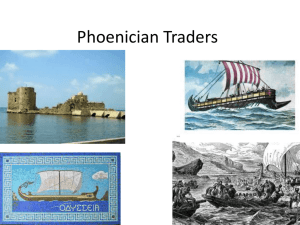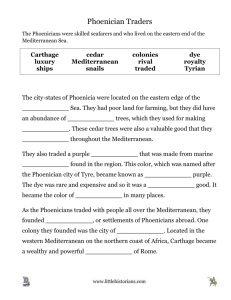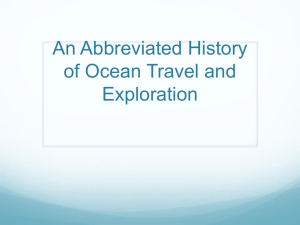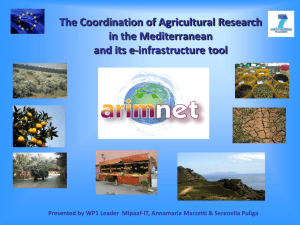Document 12260599
advertisement
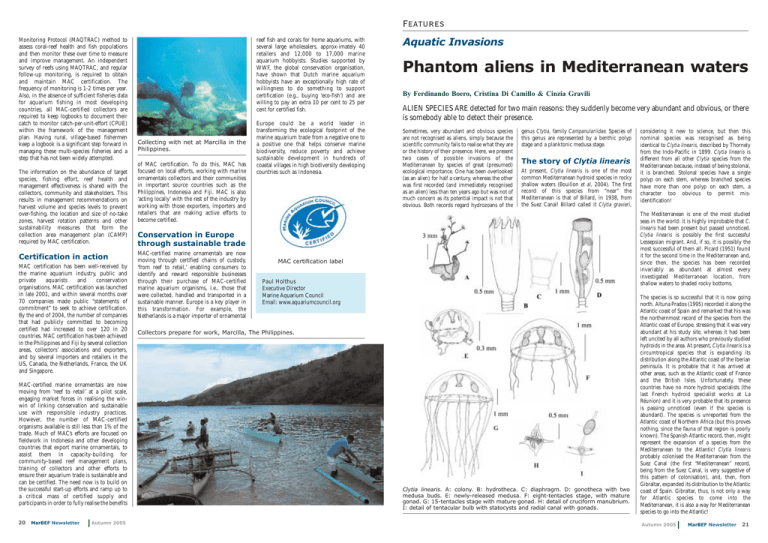
Features Monitoring Protocol (MAQTRAC) method to assess coral-reef health and fish populations and then monitor these over time to measure and improve management. An independent survey of reefs using MAQTRAC, and regular follow-up monitoring, is required to obtain and maintain MAC certification. The frequency of monitoring is 1-2 times per year. Also, in the absence of sufficient fisheries data for aquarium fishing in most developing countries, all MAC-certified collectors are required to keep logbooks to document their catch to monitor catch-per-unit-effort (CPUE) within the framework of the management plan. Having rural, village-based fishermen keep a logbook is a significant step forward in managing these multi-species fisheries and a step that has not been widely attempted. The information on the abundance of target species, fishing effort, reef health and management effectiveness is shared with the collectors, community and stakeholders. This results in management recommendations on harvest volume and species levels to prevent over-fishing, the location and size of no-take zones, harvest rotation patterns and other sustainability measures that form the collection area management plan (CAMP) required by MAC certification. Certification in action MAC certification has been well-received by the marine aquarium industry, public and private aquarists and conservation organisations. MAC certification was launched in late 2001, and within several months over 70 companies made public “statements of commitment” to seek to achieve certification. By the end of 2004, the number of companies that had publicly committed to becoming certified had increased to over 120 in 20 countries. MAC certification has been achieved in the Philippines and Fiji by several collection areas, collectors’ associations and exporters, and by several importers and retailers in the US, Canada, the Netherlands, France, the UK and Singapore. MAC-certified marine ornamentals are now moving from ‘reef to retail’ at a pilot scale, engaging market forces in realising the winwin of linking conservation and sustainable use with responsible industry practices. However, the number of MAC-certified organisms available is still less than 1% of the trade. Much of MAC’s efforts are focused on fieldwork in Indonesia and other developing countries that export marine ornamentals, to assist them in capacity-building for community-based reef management plans, training of collectors and other efforts to ensure their aquarium trade is sustainable and can be certified. The need now is to build on the successful start-up efforts and ramp up to a critical mass of certified supply and participants in order to fully realise the benefits 20 MarBEF Newsletter Autumn 2005 reef fish and corals for home aquariums, with several large wholesalers, approx-imately 40 retailers and 12,000 to 17,000 marine aquarium hobbyists. Studies supported by WWF, the global conservation organisation, have shown that Dutch marine aquarium hobbyists have an exceptionally high rate of willingness to do something to support certification (e.g., buying ‘eco-fish’) and are willing to pay an extra 10 per cent to 25 per cent for certified fish. Collecting with net at Marcilla in the Philippines. of MAC certification. To do this, MAC has focused on local efforts, working with marine ornamentals collectors and their communities in important source countries such as the Philippines, Indonesia and Fiji. MAC is also ‘acting locally’ with the rest of the industry by working with those exporters, importers and retailers that are making active efforts to become certified. Europe could be a world leader in transforming the ecological footprint of the marine aquarium trade from a negative one to a positive one that helps conserve marine biodiversity, reduce poverty and achieve sustainable development in hundreds of coastal villages in high biodiversity developing countries such as Indonesia. Aquatic Invasions Phantom aliens in Mediterranean waters By Ferdinando Boero, Cristina Di Camillo & Cinzia Gravili ALIEN SPECIES ARE detected for two main reasons: they suddenly become very abundant and obvious, or there is somebody able to detect their presence. Sometimes, very abundant and obvious species are not recognised as aliens, simply because the scientific community fails to realise what they are or the history of their presence. Here, we present two cases of possible invasions of the Mediterranean by species of great (presumed) ecological importance. One has been overlooked (as an alien) for half a century, whereas the other was first recorded (and immediately recognised as an alien) less than ten years ago but was not of much concern as its potential impact is not that obvious. Both records regard hydrozoans of the genus Clytia, family Campanulariidae. Species of this genus are represented by a benthic polyp stage and a planktonic medusa stage. The story of Clytia linearis At present, Clytia linearis is one of the most common Mediterranean hydroid species in rocky shallow waters (Bouillon et al, 2004). The first record of this species from “near” the Mediterranean is that of Billard, in 1938, from the Suez Canal! Billard called it Clytia gravieri, The Mediterranean is one of the most studied seas in the world: it is highly improbable that C. linearis had been present but passed unnoticed. Clytia linearis is possibly the first successful Lessepsian migrant. And, if so, it is possibly the most successful of them all. Picard (1951) found it for the second time in the Mediterranean and, since then, the species has been recorded invariably as abundant at almost every investigated Mediterranean location, from shallow waters to shaded rocky bottoms. Conservation in Europe through sustainable trade MAC-certified marine ornamentals are now moving through certified chains of custody, ‘from reef to retail,’ enabling consumers to identify and reward responsible businesses through their purchase of MAC-certified marine aquarium organisms, i.e., those that were collected, handled and transported in a sustainable manner. Europe is a key player in this transformation. For example, the Netherlands is a major importer of ornamental considering it new to science, but then this nominal species was recognised as being identical to Clytia linearis, described by Thornely from the Indo-Pacific in 1899. Clytia linearis is different from all other Clytia species from the Mediterranean because, instead of being stolonal, it is branched. Stolonal species have a single polyp on each stem, whereas branched species have more than one polyp on each stem, a character too obvious to permit misidentification! MAC certification label Paul Holthus Executive Director Marine Aquarium Council Email: www.aquariumcouncil.org Collectors prepare for work, Marcilla, The Philippines. Clytia linearis. A: colony. B: hydrotheca. C: diaphragm. D: gonotheca with two medusa buds. E: newly-released medusa. F: eight-tentacles stage, with mature gonad. G: 15-tentacles stage with mature gonad. H: detail of cruciform manubrium. I: detail of tentacular bulb with statocysts and radial canal with gonads. The species is so successful that it is now going north. Altuna Prados (1995) recorded it along the Atlantic coast of Spain and remarked that his was the northernmost record of the species from the Atlantic coast of Europe, stressing that it was very abundant at his study site, whereas it had been left uncited by all authors who previously studied hydroids in the area. At present, Clytia linearis is a circumtropical species that is expanding its distribution along the Atlantic coast of the Iberian peninsula. It is probable that it has arrived at other areas, such as the Atlantic coast of France and the British Isles. Unfortunately, these countries have no more hydroid specialists (the last French hydroid specialist works at La Réunion) and it is very probable that its presence is passing unnoticed (even if the species is abundant). The species is unreported from the Atlantic coast of Northern Africa (but this proves nothing, since the fauna of that region is poorly known). The Spanish Atlantic record, then, might represent the expansion of a species from the Mediterranean to the Atlantic! Clytia linearis probably colonised the Mediterranean from the Suez Canal (the first “Mediterranean” record, being from the Suez Canal, is very suggestive of this pattern of colonisation), and, then, from Gibraltar, expanded its distribution to the Atlantic coast of Spain. Gibraltar, thus, is not only a way for Atlantic species to come into the Mediterranean, it is also a way for Mediterranean species to go into the Atlantic! Autumn 2005 MarBEF Newsletter 21 Features Aquatic Invasions Dog whelks in Dutch coastal waters By Johan Craeymeersch & Mieke Rietveld THE CENTRE FOR Shellfish Research of the Netherlands Institute for Fisheries Research (RIVO) carries out yearly surveys for distribution mapping and stock assessment of the most commercially important species: mussels (Mytilus edulis), cockles (Cerastoderma edule) and trough shells (Spisula subtruncata). Clytia hummelincki: a one-week-old medusa. The story of Clytia hummelincki This species produces typical Clytia medusae (at least at release; the adult is still unknown) but the hydroid is distinct from all other Clytia because it has a subhydrothecal spherule, a feature typical of the genus Campanularia (a genus with suppressed medusae). Leloup described it from the West Indies in 1935. Other records are from South Africa, and Boero (unpublished) found it in Papua New Guinea. The species was recorded for the first time from the Mediterranean (Ionian coasts of Calabria and Apulia) by Boero et al in 1997 and, since then, from both the Adriatic and the Tyrrhenian seas (albeit unpublished). The species is expanding rapidly. It forms dense carpets at 1-2m depth, in full light, on rocks covered by encrusting coralline algae, especially those intensively grazed by sea urchins. The species is present in the summer, but the whole cycle is still unknown. Being present both in the Atlantic and in the Pacific, it is not clear if it entered the Mediterranean either from Suez Canal or from Gibraltar. The rapid expansion of this species of hydroid witnesses a great success of the medusa stage, since dispersal is mainly obtained by displacement with currents. Unfortunately, Clytia medusae are very similar to each other and are invariably identified as Clytia hemisphaerica by plankton ecologists, so the diversity of species is undetected. Biodiversity (at species level) and ecosystem functioning The ecological importance of these species, also for human purposes, resides in the feeding habits of medusae in general. Medusae feed on other plankters, from copepods to fish eggs and larvae. The medusae of Clytia do not reach large enough sizes to be recognised by a casual observer, but they are large enough to feed on copepods and larvae. The presence of new predators (in great quantities) in a given ecosystem might lead to changes in its functioning, as we have seen in the Black Sea with the case of alien ctenophores and fisheries. A decline in seasonal abundance of adult fish can be due to the presence of a predator of the larvae in a preceding period! We see the pattern (fewer fish) but we cannot understand the process leading to it (more predators, causing recruitment to be impaired) if 22 MarBEF Newsletter Autumn 2005 Clytia hummelincki. A: hydroid colony. B: Gonotheca with a single medusa bud. C: Newly-released medusa. D: 15-day-old immature medusa. (Drawings by Cristina Di Camillo). we do not know the players of the game in detail. An ecosystem service (fish for our tables) can be compromised by subtle factors that are not obvious if we measure ecosystem functioning by considering just the efficiency of biogeochemical cycles. Loss of expertise If killer whales, toxic dinoflagellates, ctenophores or frondose algae become suddenly abundant where they were previously absent or rare, their presence is immediately recognised. We do not need taxonomists to perceive such newcomers; they (or their effects) are so obvious! But nature is subtler than this. Tiny creatures of apparently no importance can have strong ecological impacts and drive ecosystem functioning in “strange” directions. We are ready to face the obvious and/or the expected, and our “predictions” work when the expected occurs, but we are less ready to perceive subtle changes in biodiversity. Their subtlety, however, might be the prelude to changes that are not subtle at all, and that makes our “predictions” very weak. Knowing the effects without knowing the causes is not a good strategy if we want to provide knowledge that leads to better management. We cannot dream of being able to manage jellyfish blooms, but at least we can detect their impact and realise that some changes in ecosystem functioning are linked to them, and not to other causes. The much-invoked ecosystem approach should lead to understanding of how ecosystems function and thus allow their goods and services to be managed. Unfortunately, there are no automatic ways to recognise species, there are no machines in which to throw a sample and produce a nice species list (and their relative abundances), having pressed a button. But this is not a good reason to disregard this information. Such things require highly specialised human expertise…and continuous monitoring, especially in periods of great change, like this one. Ferdinando Boero University of Lecce, Italy Cristina Di Camillo Politecnico delle Marche Cinzia Gravili University of Lecce Email: boero@unile.it References Altuna Prados, A, 1995. Description de Clytia linearis (Thornely, 1899) (Cnidaria, Hydrozoa) y su variabilidad en la Costa Vasca; consideraciones biocenologicas, biogeograficas y ecologicas sobre la especie. Kobie 22: 59-66 Boero, F, Gravili, C, Denitto, F, Miglietta, MP, & Bouillon, J, 1997. The rediscovery of Codonorchis octaedrus (Hydroidomedusae, Anthomedusae, Pandeidae), with an update of the Mediterranean hydroidomedusan biodiversity. Ital. J. Zool. 64: 359-365 Bouillon, J, Medel, MD, Pagès F, Gili J-M, Boero F, Gravili C, 2004. Fauna of the Mediterranean Hydrozoa. Sci. Mar. 68 Suppl. 2: 5-449 Picard, J, 1951. Notes sur quelques hydraires de la région de Banyuls. Vie Milieu 1(3): 277-278 Congratulations We would like to extend our congratulations and appreciation to Prof Ferdinando Boero who has received the Albert I Prince of Monaco Award and Manley Bendall Award 2005 from the Comité de Perfectionnement of the Oceanographic Institute in Paris for his contribution to the field of oceanography. Since 1995, 800-1,000 stations in the coastal area (up to 12km offshore) have been sampled, using a trawled or modified dredge, annually in spring. These surveys provide information on spatio-temporal variations in density, biomass and stocks of commercial species, but also result in a time-series of abundance and biomass data of another 25 infaunal and epifaunal species. One of these species is the dog whelk, Nassarius. In the period 1995-2000 only a single specimen was found, near the harbour of Rotterdam. Since then the number of observations of dog whelk has increased, and the species is extending its distribution northwards (see figure). Until recently all specimens were recorded as N. reticulatus, the netted dog whelk. In the southwestern part of the Netherlands, it is recorded from the Oosterschelde and in Greve-lingen Lake (see the EurOBIS site at MARBEF www.marbef.org/data and the ANEMOON foundation website www.anemoon.org). In the first decades of the last century the species was common in eelgrass beds in the Wadden Sea, but disappeared with the disappearance of eelgrass in the 1930s. In the same period, there were a few reports of beached live specimens (Dekker, 2004). Dekker also mentions a recent record on the Dutch coast (March 2004). Several authors consider N. reticulatus as a complex. Following reports on the morphological, genetic and ecological differences between Nassarius reticulatus sensu strictu and Nassarius nitidus (Rolàn and Luque 1994; Sanjuan et al 1997), the separation of the two species is nowadays accepted (see e.g. CLEMAM, ERMS). According to Dekker (2004), all specimens reported in the southwest of the Netherlands (Grevelingen Lake, Oosterschelde) are N. nitidus. We expected the species in the coastal waters to be N. reticulatus s.s., as N. nitidus seems to be restricted to saltmarshes and bays and is never found along open coasts Grevelingen Oosterschelde Distribution records for Nassarius observed between 1995 and 2004 in the Dutch coastal waters by the Netherlands Institute for Fisheries Research (RIVO). (Rolán, pers. comm.; Gofas, pers. comm.). In the last six months, we collected specimens from Grevelingen Lake and from coastal waters. Following Rolán and Luque (1994), we indeed identified specimens collected in Grevelingen as N. nitidus. On the southwest coast there is apparently a mixed population of N. nitidus and N. reticulatus. All specimens from the central and northern coast were identified as N. nitidus. All dog whelks in Belgian coastal waters were identified as N. reticulatus with the exception of a shallow dock in Oostende (Kerckhof, pers. comm.). In the UK, Ireland and Germany, N. reticulatus and N. incrassatus, the thick-lipped dog whelk, have been reported. According to most authors, the distribution of N. reticulatus ranges northwards to northern Norway. Others consider N. reticulatus as more or less Mediterranean-Lusitanean with its northern distribution limit at the southern British Isles, while the species in northern Europe is N. nitidus (pers. comm. of Warén in Hansson (1998). One of the main objectives of MarBEF Data Management is to integrate species distribution information into one massive data system. This database will be the European contribution to the Global Ocean Biodiversity Information System, EurOBIS. It is, therefore, fundamental that all ecologists identify species correctly. We think that, because of the new taxonomic insights and the reported distribution records, there is an urgent need to check recentlycollected specimens on a pan-European level. Here is a role for MarBEF’s Taxonomy Clearing System; integration between taxonomists and ecologists would ensure correct, up-to-date species identification. Regardless of the species actually found during our surveys, our time-series points to (re-) establishment of the dog whelk in Dutch coastal waters. Historical data are, unfortunately, rare and not easily accessible. Historical records are restricted to a few records of beached animals in the first two decades of the last century, reported as N. reticulatus. We are not aware of records between 1920 and 1995, although we could only check literature from the seventies onwards. We hope that MarBEF can finally succeed in identifying and incorporating historical data sets into an integrated database. This will take many years, but the present data clearly demonstrate the need for such a central database. The uncertainty about taxonomic identifications and distributions also has implications for the interpretation of the observed distributional changes in Dutch coastal waters. For the sake of this discussion, we assume that N. reticulatus is a southern species, that N. nitidus has occurred in the North Sea up until now (besides N. Autumn 2005 MarBEF Newsletter 23


